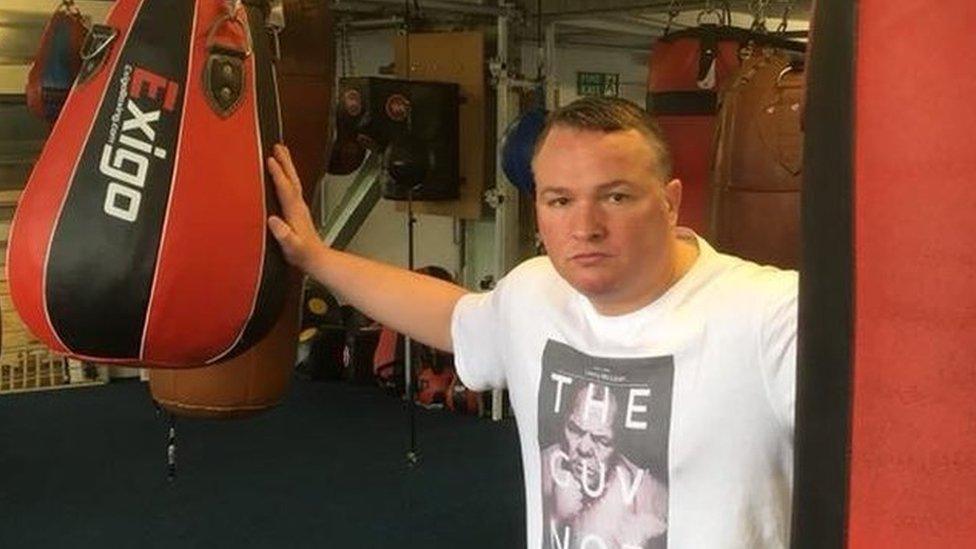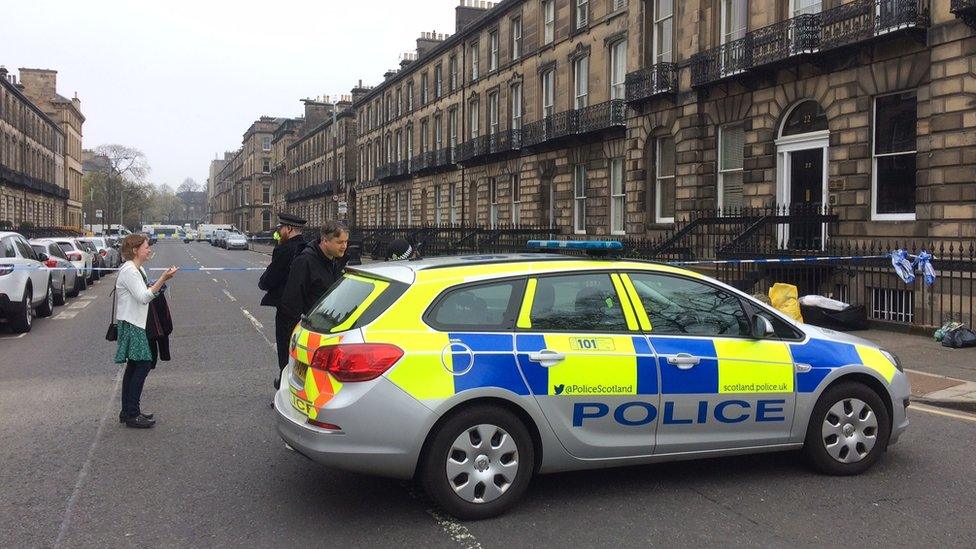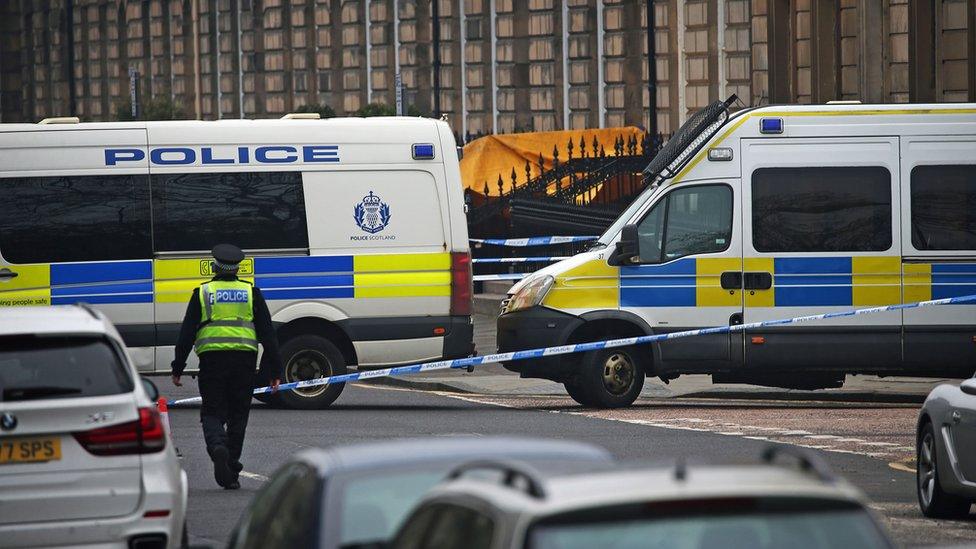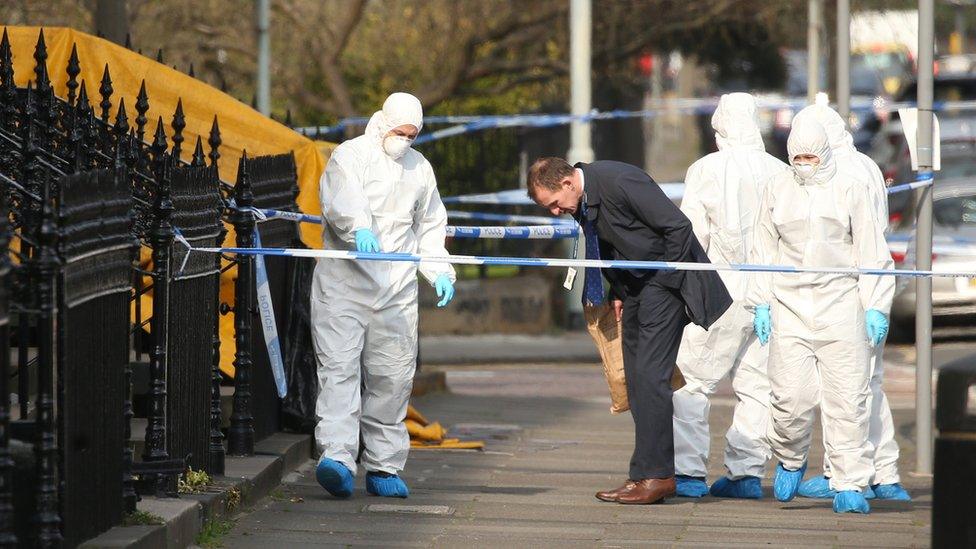Bradley Welsh murder accused 'committed outrageous, cowardly act'
- Published

Bradley Welsh was shot from close range
The man accused of murdering T2 Trainspotting actor Bradley Welsh committed "an absolutely outrageous and cowardly act", a jury has been told.
Mr Welsh, 48, was fatally shot outside his flat in Edinburgh on 17 April 2019.
Sean Orman, 30, denies murdering the former boxer and the attempted murder of David McMillan the month before.
In his closing speech after an 11-day trial, prosecutor Richard Goddard QC said there had been evidence from eye witnesses, CCTV, DNA and phone records.
Mr Goddard told the jury at the High Court in Edinburgh: "What you have is the collective strength of 21 separate circumstances arising from different sources of evidence."
He added they were "all pointing the same way and forming an overwhelming case that Sean Orman is responsible".
However, in the closing speech for the defence, Advocate Ian Duguid QC told jurors his client Sean Orman was involved in crime but was not responsible for killing Bradley Welsh.
'Unbelievable twist of fate'
Mr Welsh was shot in the head from close range outside his home in the city's Chester Street.
A witness told the jury that three weeks before the murder, Sean Orman told him he was going to shoot Mr Welsh and showed him the gun he was going to use.
Dean White said Mr Orman fired the gun into the floor of the flat they were in at the time. Afterwards, Mr White called the police to warn them what was going to happen.
He told detectives that Mr Orman was being paid £10,000 by a man called George Baigrie to kill Mr Welsh.
"The inescapable fact is that Dean White reported that the accused Sean Orman was going to shoot Bradley Welsh with a shotgun a little over three weeks before it actually happened," said Mr Goddard.
"It would have to be an extraordinary, unbelievable twist of fate for all of the things he predicted to fall into place just three weeks later. Pause and imagine the odds on that."

Bradley Welsh was killed outside his flat in Chester Street, Edinburgh
The prosecutor said firearms experts later found a hole in the floor of the flat, providing further support for Mr White's account.
Mr Goddard said there was evidence linking Mr Orman to a Ford Kuga used by the man who shot Mr Welsh to drive to the scene and escape afterwards.
Mr Orman's DNA was found on the steering wheel and gearstick of the car, which was driven to Kirknewton after the shooting.
The jury was told that the man who shot Mr Welsh was wearing distinctive trainers and there was CCTV of Mr Orman wearing identical shoes in Kirknewton after the shooting, close to the place where the getaway car was left.
Firearms residue
Mr Goddard said the gunman had been wearing black fitted tracksuit bottoms, as had Mr Orman. Firearms discharge residue found in the pockets of Mr Orman's trousers had matched firearms discharge residue found at the scene of Mr Welsh's murder.
Two eye witnesses to the shooting had told the trial that Mr Orman resembled the gunman.
Mr Goddard said that five days after the murder, police arrested Mr Orman after "a truly shocking" 20-minute car chase through Edinburgh. At one stage, he drove at 123mph on the city bypass and 90mph on Gorgie Road in the city centre.
"All of that tells us that Sean Orman was willing to go to any lengths to avoid capture by the police", he said.
Mr Goddard described Mr Orman's defence as "far-fetched" and "seemed to put the evidence down to coincidence and bad luck".

Police near the scene of the shooting in April 2019
Summing up for Mr Orman's defence case, Mr Duguid told jurors that the people involved in the case were also involved in gangland activities. He said the case had "the hallmarks of organised crime".
"The assumption is that an assassin or hitman has been hired for money to attack Mr McMillan and to murder Mr Welsh," he said.
Mr Duguid said it was evident that some of the personalities involved were connected to organised crime.
He said Bradley Welsh had been driving around with cable ties, false number plates and a knife in his car, and had covert body armour and a baton inside his house.
'Credible and reliable evidence'
The accused was a resetter, a man who moved stolen cars for money and was involved in other criminality, he said.
Mr Duguid said the personalities involved did not matter: "What you are looking for is credible and reliable evidence."
He said two other people were said to have been present when Dean White heard Sean Orman talk about shooting Mr Welsh, but neither had been called to give evidence. And two other people who were mentioned during the prosecution case had not been called.

A forensic team near the scene of the shooting
Mr White's "crucial" account had been contradicted by other evidence, Mr Duguid said. He asked the jurors whether he was a credible and reliable witness.
Mr Duguid said two eye witnesses to the shooting had gone no further than saying Orman resembled the gunman. He asked whether that was good enough and questioned the fairness of a video identity parade.
Sean Orman had admitted driving the Ford Kuga on the day of the killing, but Mr Duguid said there was no CCTV that identified who was driving the vehicle before and after the murder, or how many people were inside it.
Mr Duguid said there could be another explanation for the firearms discharge residue being on Orman's trousers.
"If you have a reasonable doubt about Sean Orman's identification as the assassin of Bradley Welsh, then you have to acquit him."
The jury will retire to consider its verdict on Friday.